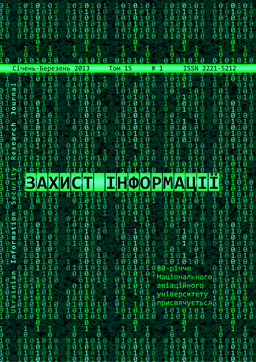Аналіз послідовної атаки пасивного перехоплення декількох зловмисників на пінг-понг протокол з переплутаними парами кубітів
DOI:
https://doi.org/10.18372/2410-7840.15.4217Ключові слова:
квантова криптографія, пінг-понг протокол, атака пасивного перехоплення декількох зловмисників, імовірність виявлення атаки, кількість інформації зловмисниківАнотація
У статті проаналізовано послідовну атаку пасивного перехоплення двох і більшого числа зловмисників на оригінальний пінг-понг протокол з парами переплутаних кубітів. Отримано загальний рекурсивний вираз для імовірності d виявлення атаки довільної кількості n зловмисників, що дозволяє обчислити цю імовірність через відповідну імовірність при атаці n – 1 зловмисників. Показано, що збільшення кількості атакуючих у квантовому каналі призводить до збільшення ймовірності виявлення їх атаки легітимними користувачами. Отримано вирази для максимальної кількості інформації зловмисників при послідовній атаці двох і трьох зловмисників. Показано, що максимальна кількість інформації зловмисників визначається тим же виразом, що й у випадку атаки одного зловмисника, змінюється тільки величина d. Показано, що пінг-понг протокол з парами переплутаних кубітів вразливий до атаки пасивного перехоплення декількох зловмисників не більше, ніж до атаки одного.
Посилання
Boström K. Deterministic secure direct communication using entanglement / K. Boström, T. Felbinger // Physical Review Letters. – 2002. – Vol. 89, issue 18. – 187902.
Cai Q.-Y. Improving the capacity of the Boström – Felbinger protocol / Q.-Y. Cai, B.-W. Li // Physical Review A. – 2004. – V. 69, issue 5. – 054301.
Василиу Е.В. Анализ безопасности пинг-понг протокола с квантовым плотным кодированием / Е.В. Василиу // Наукові праці ОНАЗ ім. О.С. Попова. – 2007. – № 1. – С. 32–38.
Vasiliu E.V. Non-coherent attack on the ping-pong protocol with completely entangled pairs of qutrits / Eugene V. Vasiliu // Quantum Information Pro-cessing. – 2011. – V. 10, num. 2. – P. 189–202.
Li X.-H. Multiparty Quantum Remote Secret Con-ference / X.-H. Li, C.-Y. Li, F.-G. Deng et al // Chinese Physics Letters. – 2007. – V. 24, № 1. – P. 23–26.
Jin X.-R. Three-party quantum secure direct com-munication based on GHZ states / X.-R. Jin, X. Ji, Y.-Q. Zhang et al // Physics Letters A. – 2006. – V. 354, № 1-2. – P. 67–70.
Василиу Е.В. Пинг – понг протокол с трех– и четырехкубитными состояниями Гринбергера – Хорна – Цайлингера / Е.В. Василиу, Л.Н. Василиу // Труды Одесского политехнического университета. – 2008. – Вып. 1(29). – С. 171–176.
Ostermeyer, M. On the implementation of a deter-ministic secure coding protocol using polarization entangled photons / M. Ostermeyer, N. Walenta // Optics Communications. – 2008. – V. 281, issue 17. – P. 4540–4544.
Jung E. Attack of many eavesdroppers via optimal strategy in quantum cryptography / E. Jung, M.-R. Hwang, D.K. Park [et al.] // Physical Review A. – 2009. – V. 79, issue 3. – 032339.
Василиу Е.В. Синтез основанной на пинг-понг протоколе квантовой связи безопасной системы прямой передачи сообщений / Е.В. Василиу, С.В. Николаенко // Наукові праці ОНАЗ ім. О.С. Попова. – 2009, № 1. – С. 83–91.
Boström K. Deterministic secure direct communication using entanglement / K. Boström, T. Felbinger // Physical Review Letters, 2002, Vol. 89, issue 18. – 187902.
Cai Q.-Y. Improving the capacity of the Boström – Felbinger protocol / Q.-Y. Cai, B.-W. Li // Physical Review A., 2004, V. 69, issue 5. – 054301.
Vasiliu Ye.V. Security analysis of ping-pong protocol with quantum thick coding / Ye.V.Vasiliu // Science works of ONAZ n.a. O.S.Popov, 2007, № 1, P. 32–38.
Vasiliu E.V. Non-coherent attack on the ping-pong protocol with completely entangled pairs of qutrits / Eugene V. Vasiliu // Quantum Information Pro-cessing, 2011, V. 10, num. 2, P. 189–202.
Li X.-H. Multiparty Quantum Remote Secret Con-ference / X.-H. Li, C.-Y. Li, F.-G. Deng et al // Chinese Physics Letters, 2007, V. 24, № 1, P. 23–26.
Jin X.-R. Three-party quantum secure direct com-munication based on GHZ states / X.-R. Jin, X. Ji, Y.-Q. Zhang et al // Physics Letters A, 2006, V. 354, № 1-2, P. 67–70.
Vasiliu Ye.V. Ping-pong protocol with 3- and 4-qubits Greenberger-Horne-Zeilinger states / Ye.V.Vasiliu, L.N.Vasiliu // Works of Odessa polytechnic university, 2008, Vol. 1(29), P. 171–176.
Ostermeyer, M. On the implementation of a deter-ministic secure coding protocol using polarization entangled photons / M. Ostermeyer, N. Walenta // Optics Communications., 2008, V. 281, issue 17. – P. 4540–4544.
Jung E. Attack of many eavesdroppers via optimal strategy in quantum cryptography / E. Jung, M.-R. Hwang, D.K. Park [et al.] // Physical Review A. – 2009. – V. 79, issue 3. – 032339.
Vasiliu Ye.V. Synthesis of safety system direct mes-sage transferring based on ping-pong protocol of quantum communications / Ye.V.Vasiliu, S.V.Niko-laenko // Science works of ONAZ n.a. O.S.Popov, 2009, № 1, P. 83–91.
##submission.downloads##
Опубліковано
Номер
Розділ
Ліцензія
Автори, які публікуються у цьому журналі, погоджуються з наступними умовами:- Автори залишають за собою право на авторство своєї роботи та передають журналу право першої публікації цієї роботи на умовах ліцензії Creative Commons Attribution License, котра дозволяє іншим особам вільно розповсюджувати опубліковану роботу з обов'язковим посиланням на авторів оригінальної роботи та першу публікацію роботи у цьому журналі.
- Автори мають право укладати самостійні додаткові угоди щодо неексклюзивного розповсюдження роботи у тому вигляді, в якому вона була опублікована цим журналом (наприклад, розміщувати роботу в електронному сховищі установи або публікувати у складі монографії), за умови збереження посилання на першу публікацію роботи у цьому журналі.
- Політика журналу дозволяє і заохочує розміщення авторами в мережі Інтернет (наприклад, у сховищах установ або на особистих веб-сайтах) рукопису роботи, як до подання цього рукопису до редакції, так і під час його редакційного опрацювання, оскільки це сприяє виникненню продуктивної наукової дискусії та позитивно позначається на оперативності та динаміці цитування опублікованої роботи (див. The Effect of Open Access).

